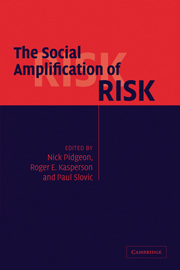Book contents
- Frontmatter
- Contents
- List of figures
- List of tables
- List of contributors
- Acknowledgments
- Introduction
- Part I Conceptual foundations
- Part II Risk signals and the mass media
- Part III Public perceptions and social controversy
- 9 The dynamics of risk amplification and attenuation in context: a French case study
- 10 Public response to Y2K: social amplification and risk adaptation: or, “how I learned to stop worrying and love Y2K”
- 11 The social dynamics of environmental risk perception: implications for risk communication research and practice
- 12 Understanding amplification of complex risk issues: the risk story model applied to the EMF case
- Part IV Risk ripples and stigma effects
- Part V Policy and management
- Bibliography
- Index
10 - Public response to Y2K: social amplification and risk adaptation: or, “how I learned to stop worrying and love Y2K”
Published online by Cambridge University Press: 06 July 2010
- Frontmatter
- Contents
- List of figures
- List of tables
- List of contributors
- Acknowledgments
- Introduction
- Part I Conceptual foundations
- Part II Risk signals and the mass media
- Part III Public perceptions and social controversy
- 9 The dynamics of risk amplification and attenuation in context: a French case study
- 10 Public response to Y2K: social amplification and risk adaptation: or, “how I learned to stop worrying and love Y2K”
- 11 The social dynamics of environmental risk perception: implications for risk communication research and practice
- 12 Understanding amplification of complex risk issues: the risk story model applied to the EMF case
- Part IV Risk ripples and stigma effects
- Part V Policy and management
- Bibliography
- Index
Summary
As the world approached the change of the millennium, intense public interest became focused on the possible consequences of potential failures in computer technologies. These potential failures arose because the mechanism for storing and calculating dates failed to differentiate adequately between the turn of the previous century (1900) and the turn of the millennium (2000 or “Y2K”). In many industrialized nations, much effort was expended by government and industry to insure that critical computer systems, such as Air Traffic Control and financial systems, had been properly “debugged.” Though no official tabulation of Y2K costs has yet been done, estimates reported in the media suggest that in the United States approximately $100 billion was expended by government and industry to identify and correct computer problems relating to the Y2K bug, and to prepare for possible disruptions at the turn of the millennium. On the world level, media estimates for Y2K remediation and preparedness are in the $450 billion range. However, despite this high level of effort, press reports left the impression that some systems were inadequately prepared and that regional and local computer systems may have been, in many cases, completely unprepared. Thus, the potential consequences of the “millennium bug” (as some have called it) were not entirely predictable. Indeed, newspaper reports yielded predictions of everything from minor inconveniences (e.g. bank difficulties for a day or two) to major failures of critical infrastructure, including financial markets, electric power control and distribution, telephone service, and food distribution.
- Type
- Chapter
- Information
- The Social Amplification of Risk , pp. 243 - 261Publisher: Cambridge University PressPrint publication year: 2003
- 11
- Cited by



